8 Oct 2006
Arm Twisting And Frustration at Douala Airport
On September 22nd 2006, I set off with my wife for a holiday trip to South Africa at the invitation of loved ones resident in that country. We arrived Douala International airport at midday, checked in, paid the mandatory ‘airport tax’ of about $20 dollars each, got our passports stamped and were going through the final security check when a female police officer asked my wife to step aside. The policewoman asked her what she was going to do in South Africa? I replied that she was my wife and we are traveling together for holidays. The policewoman then asked for the invitation letter from our host in South Africa and I presented it. She even searched my wife’s bag in case she may find anything incriminating to no avail. Not convinced, she asked for our marriage certificate. I told her that we did not bring it along because nowhere has it been stated that couples must travel with the document. I reminded her that the marriage certificate was presented to the South African High Commission as one of the documents required to grant us a visa. As the argument progressed, an elderly male police officer in mufti called his colleague to the side for a tete a tete. She came back and said that my wife was not going to travel with me and that I was pretending that she was my wife. “I wish you were making this statement in the presence of our 15year-old son.” I angrily told her. They employed a combination of threats and delay tactics to apply pressure on us so as to hype the bargain. In the end we were allowed to go. Do not ask me how we resolved the conflict. In this our triangle of a nation, not everything has to be explained.
We then moved to the waiting room 22 at the departure terminal only to be told that the Ethiopian airline flight will be delayed for more than an hour. The room has a sitting capacity for more than 112 people with one functional toilet. We patiently waited for boarding time that was around 4pm.
Take Off For Johannesburg via Addis Ababa
We eventually boarded the Boeing 767 300 ER aircraft for the first leg of our journey to Addis Ababa. The aircraft with seat capacity of 236 was relatively new and the flight to Addis was smooth. We arrived Addis Ababa late into the night after traveling for about 5 hours and spent quite some time to get through the process of being allocated a hotel to spend the night. It was a cold night in Addis as we stepped out of the airport to board the bus that was taking us to the hotel. It was a pitiful sight to notice dozens of obviously homeless poor people curdling themselves in the cold in front of the airport. Passengers traveling from Cameroon to South Africa by Ethiopian airlines routinely pass a night in Addis Ababa on their way to and from South Africa. The following morning, we boarded a much older aircraft- a Boeing 757-260 from Addis Ababa to Johannesburg. After about five hours of flight, we started the descent to the Johannesburg International airport. The landscape around Johannesburg as seen from the air was flat and wore a face of aridity. We set our feet on the South African soil for the first time on this bright Saturday afternoon, went through immigration and customs with no hitch and proceeded to meet our hosts that were patiently waiting for us given that our flight to Johannesburg was delayed for more than one hour.
Johannesburg, Pretoria
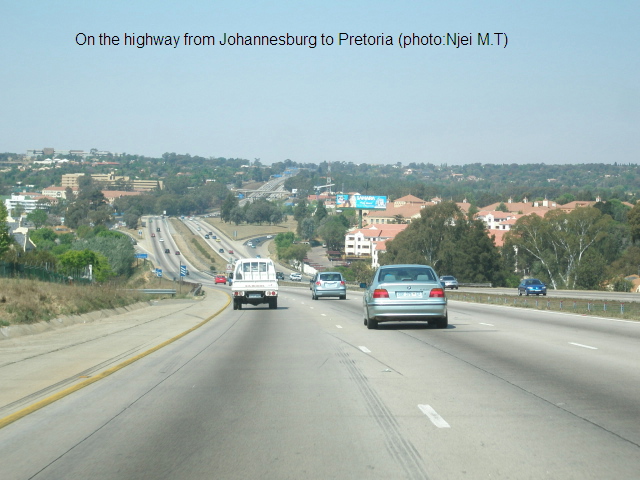
A highway in South Africa. The country has a good road network
As we drove to the house from the airport, I took note of the nice roads, the aesthetic surroundings, and hundreds of low and middle-income houses some constructed by the ANC government to try and ease the pressure of housing. It was not to be long before I started seeing the practical symbols of the insecurity of Johannesburg. This city of more than 3 million has a reputation as one of the most violent cities in the world. A typical residence in a rich Johannesburg neighborhood is usually enclosed behind high walls. Wiring connected to electricity may be added at the top of the walls. In addition, surveillance cameras monitor the premises round the clock and some compounds contract armed security companies to intervene in cases of any emergency.
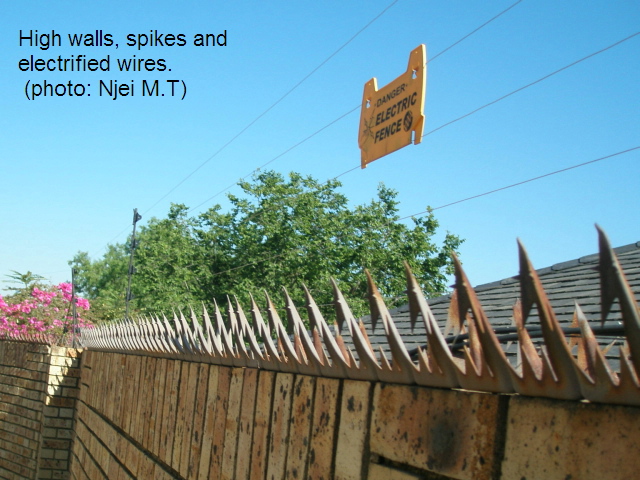
Re-inforced security: Rich South African residents invest heavily on security
Our hosts live in Bryanston, a Johannesburg neighborhood with cutting age residential apartments that can compete with any comfortable housing anywhere in the world. They were very receptive to us and another visiting couple. We easily became an enlarged happy family of three couples for the brief period we were together. We all attended church service on Sunday morning at the St. Mungo’s United Church in the neighborhood. The sermon had the theme ‘He is able’ and the congregation was more than 80% white. I remember my wife asking me if whites are a majority in South Africa. I told her that whites are a minority in South Africa but are a majority in this rich neighborhood hence the composition of church attendance. By the time we got to the Central bus station the following day to board a bus to Bloemfontein, I told her to count how many whites were there. She then realized that almost everybody around was black. In today’s South Africa, statutory segregation has ended but practical social segregation is still a fact of life. It will be many years down the road for integration to become a reality.
After lunch on Sunday, our hosts decided to take us to the city of Pretoria (South Africa’s administrative headquarters).
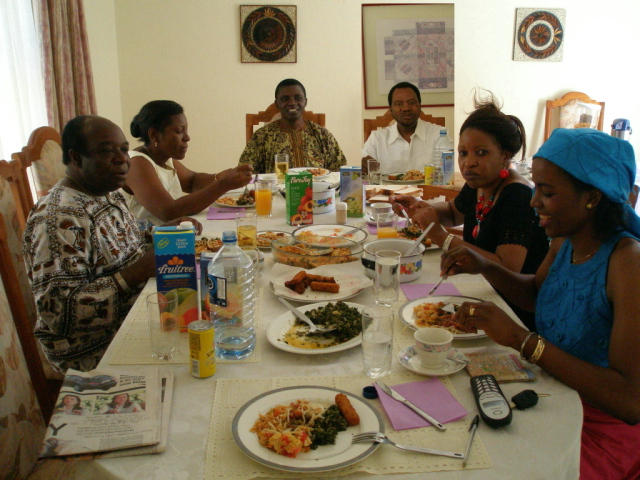
Lunch at the Nyambis in Johannesburg
The road to Pretoria is sparse and well constructed and there are private settlements or business buildings all along the road. I could not distinguish the geographical boundary between Johannesburg and Pretoria. An imposing University of South Africa (UNISA) building greeted us as we drove into central Pretoria. Pretoria is a neatly planned city and less boisterous than Johannesburg. We drove pass the official residence of the South African president and it was interesting to note that the street we were using was sharing boundaries with the walls of the presidency. Our hosts took us to a KFC (Kentucky Fried Chicken) fast food shop to pick up some purchases. The ‘Americanization’ of eating habits among South Africa’s elites is almost total. As a consequence, obesity is fast becoming a growing health problem for this class of citizens.
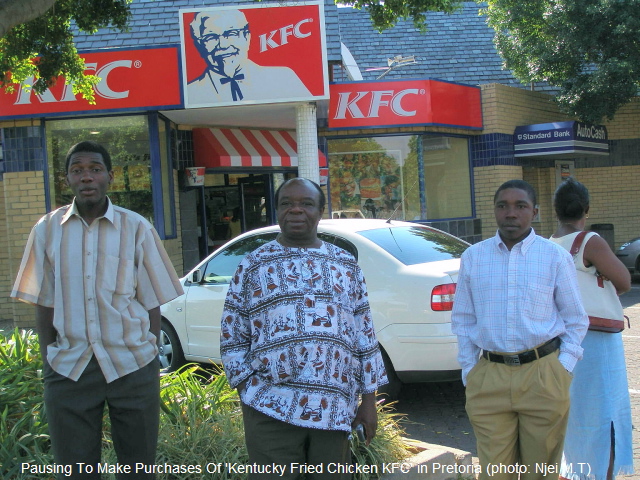
Fast food shop in Pretoria : 'Americanization' of eating habits
Apart from sightseeing, we paid a visit to the Silver Lakes residence of Henry Fomundam (pharmacist involved in the fight against HIV/AIDS in the Southern Africa region). The Silver Lakes settlement we visited is relatively new with exquisite houses of various designs and luxury complete with a neighborhood golf course. When I compare these housing complexes with the stone-age shacks inhabited by some South Africans, it begins to dawn on me that this country has a complex social problem. At the time of visiting, the Fomundams were hosting a couple that came from Cameroon for medical treatment. Mbah Jonathan was rendered blind by bullets from an armed robber’s gun during an attempted robbery in Cameroon in 2004. With the assistance of the Fomundams, Jonathan was in Pretoria battling to regain part or all of his sight with the help of a ‘cornea transplant’ that was programmed for him.
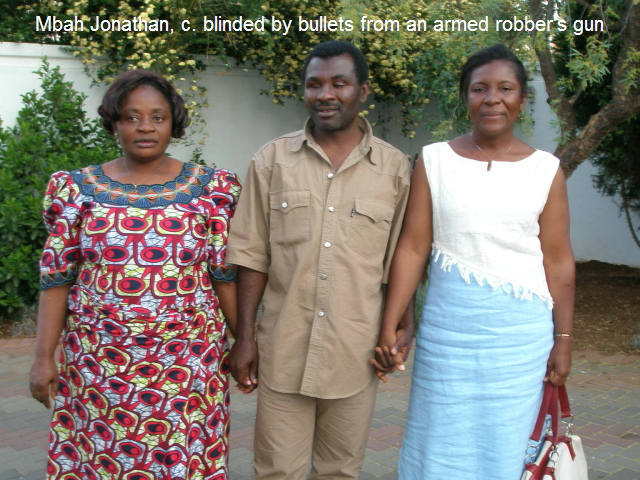
Jonathan: Seeking medical attention in South Africa
I did appreciate the support the Fomundams were according this couple especially as this was not their first time of rendering this service to them. After a sumptuous dinner at the Fomundams we left for Johannesburg shortly before nightfall. We entered Johannesburg in the night and drove around downtown Johannesburg to have a feel of the city at night. The Hillbrow area that used to be the commercial nerve center of Johannesburg was partially deserted some years back by businesses due to the menace of criminals. Shopping complexes moved to more secure areas of the city like Sandton. Today, Sandton area is booming with round-the-clock restaurants, theatres and casino. An imposing statue of Nelson Mandela, a fountain, a library and a string of restaurants share the same neighborhood in Sandton, Johannesburg.
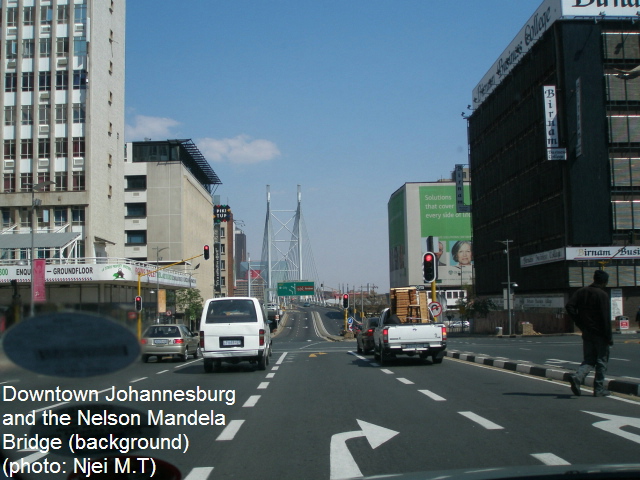
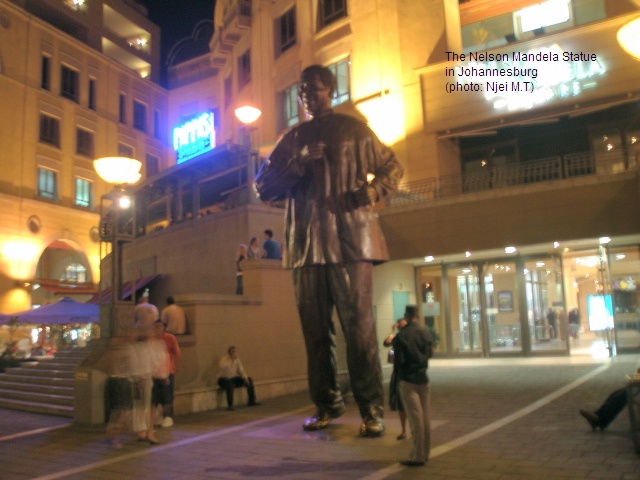
Johannesburg street (left) and the Mandela statue (right)
Johannesburg is a city where the one word that is on everybody’s lips is ‘insecurity’. Upon arrival in the city, you quickly learn that you have to be discrete and try to blend in with the city dwellers. It is not necessarily in your interest to overtly demonstrate that you are a foreigner. Xenophobic behaviour, especially that directed against African immigrants is not uncommon in South Africa. South Africa shoulders a burden of many African immigrants from such poorer neighbours like Zimbabwe, Tanzania and Mozambique and also from far away rich but poorly managed countries like Nigeria and Cameroon. The defunct Apartheid system of government prevented millions of blacks from acquiring the education and the necessary skills to help them integrate into their country’s modern economy. As a consequence, the unemployment rate in South Africa is close to 40% even as the economy records continuous growth for over four consecutive years.
Bloemfontein
We left Johannesburg by bus on September 25th at 5.30pm for the five hours journey to Bloemfontein. On the outskirts of Johannesburg, rows of squatter camps comprising shameful shacks scattered the landscape along the road. Some of South Africa’s poorest of the poor live in these despicable structures. This is happening in a country with more than 42,000 super-rich individuals that possess personal wealth above a million U.S dollars. We arrived Bloemfontein and were received at the bus station by prof. Acho Thomas-our host and Mathemetics professor at the University of The Free State, Bloemfontein. Our host took us to his farm residence some 20 minutes away on the outskirts of Bloemfontein. Bloemfontein used to be one of the bastions of the Boers or Afrikaners (white settlers with ancestral roots in Holland).
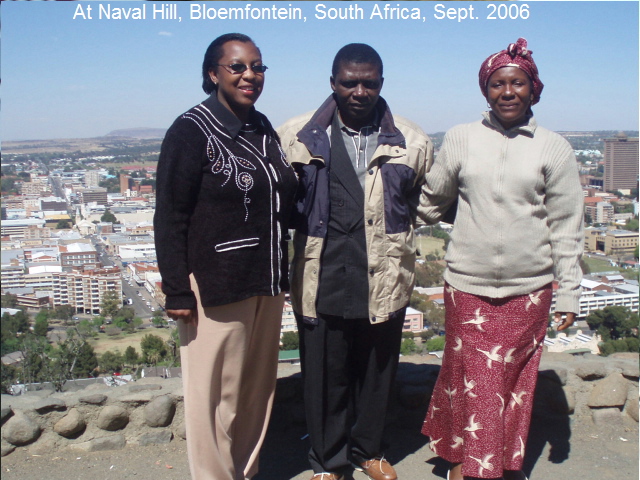
The settlement patterns they created in the surrounding areas of Bloemfontein typically comprise of single families inhabiting a fenced settlement in a fenced farmland. When you live on these settlements, the distance between your house and that of your nearest neighbor can range from one kilometer to more than twenty kilometers depending on the size of your farm or your neighbour’s. My friend, his wife Susan and their two children live on their farm settlement with their four wild dogs, some geese, a cow, some domestic fowls and sheep. It has to be added that these settlements have everything from electricity, running water, bore holes, water storage tanks, irrigation pipes and water pumping motors.
I took sometime to walk around and admire the flat and sparse surroundings. I was shown a barn stocked full with maize or corn (West African appellation) but which is called ‘milice’ in South Africa. In like manner, the South Africans call traffic lights ‘robots’ and a filling station ‘garage’. When a South African says that ‘You must go that way’ he really means to say ‘You should go that way’. Sometimes little deviations in English language like these usually confuse visitors. On the second day of our stay in Bloemfontein, we visited some shopping centers, and other places of interest including the Military Museum and The Anglo-Boer War Museum and Women’s Memorial. We also visited the Naval Hill in the night. It was very exciting to enjoy a panoramic view of the brightly colored lights from the city of Bloemfontein from this elevated position.
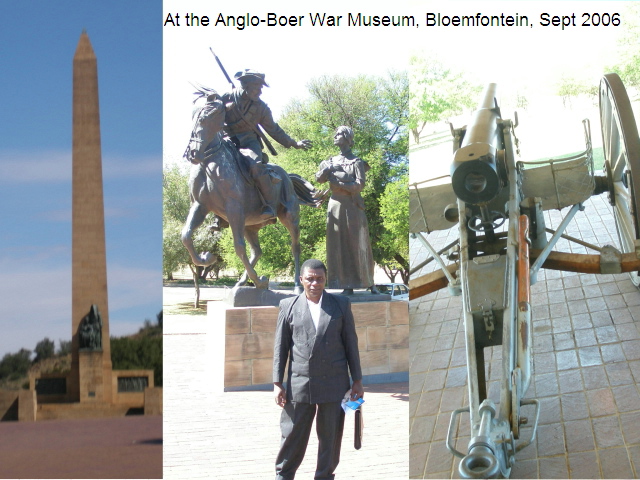
Maseru, Lesotho
The following day, our hosts took us for a visit to the kingdom of Lesotho. This small mountain kingdom of about two million people is completely surrounded by South Africa and the capital city Maseru is situated at the border. Maseru is about 140 kilometres from Bloemfontein and a highway links the two cities. Some 50 to 60 kilometres on the way to Maseru are to be found the predominantly black townships of Botshabelo and Thaba Nchu. Under Apartheid many black labourers serving the city of Bloemfontein resided here and were ferried to Bloemfontein everyday. Apartheid laws forbade blacks from certain areas esp. in the cities at night. We crossed into Lesotho through the Maseru bridge border post after completing immigration formalities.
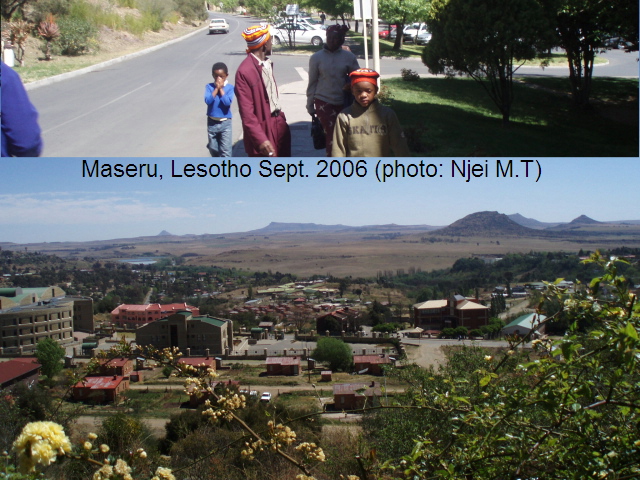
Even though Lesotho has her own currency, the South African Rand is freely accepted. We drove briefly around Maseru, admired some people wrapped in their traditional blanket attire and then settled for some snacks at the Lesotho Sun hotel. English and Sesotho are official languages. Literacy rate is 86% and over 90% of the people are Christians. Life expectancy at birth is 37 years and the main occupation is pastoral farming. We returned from Lesotho to spend our last night in Bloemfontein before departure for Johannesburg the following day.
(See photo of a hill used as billboard in Maseru at this link below)
http://www.njeitimah-outlook.com/albums/album_image/2075996/1145331.htm
Homeward Bound
After some shopping around Bloemfontein in the morning, we had pizza for lunch, packed our bags and headed for the bus station. We took off at 4pm on Sept. 21 and arrived Johannesburg at 10 pm. We spent our last night at Johannesburg before our departure for Addis the following day. In the morning of Sept 22, Hanson Nyambi drove us to a shopping center in Johannesburg for last minute purchases before departure. We later visited Olivia Mbazang in her office before jointly proceeding to the airport for our flight at 2.30pm. As the plane took off, I started making a keen observation of the land located about 10 km below the aircraft as we flew over Zimbabwe, Mozambique and Malawi before nightfall. The land spanning from Johannesburg through Zimbabwe into Mozambique appeared to be mostly arid. As we moved from Mozambique into Malawi, dotted vegetation started to emerge. We flew over the 580 km long lake Malawi shortly before nightfall. We crossed Tanzania and Kenya in the night before landing at Addis at 10pm. We were lodged at the Hotel de Leopol on Jomo Kenyata road Addis Ababa. (See photo in Addis at this link: http://www.njeitimah-outlook.com/albums/album_image/2075996/1145343.htm)
This hotel had better services and better facilities than those we had at the Abraham hotel on our way to South Africa. In the morning of Saturday, we boarded our flight bound for Douala. There were clear skies over Ethiopia, Sudan and Central African Republic. I had the opportunity to observe interesting features including the river nile, the gorges of what was certainly the rift valley, and a pattern of landscape that comprise bare hills and valleys covered with green vegetation. As we approached the border between Cameroon and CAR, the skies became cloudy and I could not see the surface of Cameroon until we were descending to land at Douala International Airport. It was as if the gods of Cameroon were trying to hide something from me-perhaps the deforestation.
Conclusion
The visit to South Africa was short but memorable. It gave us the opportunity to meet wonderful people and enjoy their largesse and hospitality. It also gave us the opportunity to see, feel and appreciate the problems encountered by the ANC government in trying to transform post-Apartheid South Africa into a modern non-racial state. We remain deeply indebted to our hosts.
See video of Bloemfontein at this link
http://www.youtube.com/watch?v=iUtxMoN1cvU
N.B. Also view other photos related to this trip that do not appear on my website at the link below
http://www.flickr.com/photos/njei_timah/
Njei Moses Timah
|